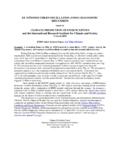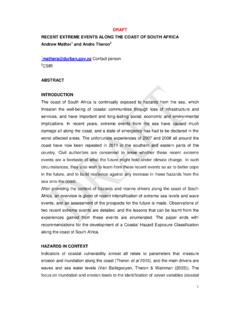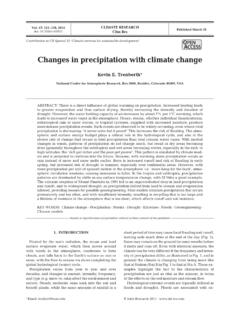Transcription of Baker and Siemens v9 - Columbia University
1 Educational Data Mining and Learning Analytics Ryan Baker , Teachers College, Columbia University George Siemens , Athabasca University 1. Introduction During the last decades, the potential of analytics and data mining methodologies that extract useful and actionable information from large datasets--has transformed one field of scientific inquiry after another (cf. Summers et al., 1992; Collins et al., 2004). Analytics has become a trend over the last several years, reflected in large numbers of graduate programs promising to make someone a master of analytics, proclamations that analytics skills offer lucrative employment opportunities (Manyika et al.)
2 , 2011), and airport waiting lounges filled with advertisements from different consultancies promising to significantly increase profits through analytics. When applied to education, these methodologies are referred to as learning analytics (LA) and educational data mining (EDM). In this chapter, we will focus on the shared similarities as we review both parallel areas, while also noting some important differences. Using the methodologies we describe in this chapter, one can scan through large datasets to discover patterns that occur in only small numbers of students or only sporadically (cf. Baker et al., 2004; Sabourin et al.
3 , 2011); one can investigate how different students choose to use different learning resources and obtain different outcomes (cf. Beck et al., 2008); one can conduct fine-grained analysis of phenomena that occur over long periods of time (such as the move towards disengagement over the years of schooling -- cf. Bowers, 2010); and one can analyze how the design of learning environments may impact variables of interest through the study of large numbers of exemplars (cf. Baker et al., 2009). In the sections that follow, we argue that learning analytics has the potential to substantially increase the sophistication of how the field of learning sciences understands learning, contributing both to theory and practice.
4 The emergence of analytics Compared to sciences such as physics, biology, and climate science, the learning sciences are relatively late in using analytics. For example, the first journal devoted primarily to analytics in the biological sciences, Computers in Biology and Medicine, began publication in 1970. By contrast, the first journal targeted towards analytics in the learning sciences, the Journal of Educational Data Mining, began publication in 2009, although it was preceded by a conference series (commencing in 2008), a workshop series (commencing in 2005), and earlier workshops in 2000 and 2004. There are now several venues that promote and publish research in this area -- currently including the Journal of Educational Data Mining, the Journal of Learning Analytics, the International Conference on Educational Data Mining, the Conference on Learning Analytics and Knowledge (referred to below as LAK )
5 , as well as a growing emphasis on research in this area at conferences such as the International Conference on Artificial Intelligence in Education, ACM Knowledge Discovery in Databases, the International Conference of the Learning Sciences, and the annual meeting of the American Educational Research Association. The use of analytics in education has grown in recent years for four primary reasons: a substantial increase in data quantity, improved data formats, advances in computing, and increased sophistication of tools available for analytics. Quantity of Data One of the factors leading to the recent emergence of learning analytics is the increasing quantity of analyzable educational data.
6 Considerable quantities of data are now available to scientific researchers through public archives like the Pittsburgh Science of Learning Center DataShop (Koedinger et al., 2010). Mobile, digital, and online technologies are increasingly utilized in many educational contexts. When learners interact with a digital device, data about that interaction can be easily captured or logged and made available for subsequent analysis. Papers have recently been published with data from tens of thousands of students. With the continued growth of online learning (Allen and Seamen, 2013) and the use of new technologies for data capture (Choudhury and Pentland, 2003), even greater scope of data capture during learning activities can be expected in the future, particularly as large companies such as Pearson and McGraw-Hill become interested in EDMand Massive Online Open Courses (MOOCs) and providers such as Coursera, edX, and Udacity generate additional data sets for research (Lin, 2012).
7 Data formats Baker recalls his first analysis of educational log data; almost two months were needed to transform logged data into a usable form. Today, there are standardized formats for logging specific types of educational data (cf. Koedinger et al., 2010), as well as considerable knowledge about how to effectively log educational data, crystallized both in scientific publications and in more informal knowledge that is disseminated at conferences and in researcher training programs like the Pittsburgh Science of Learning Center Summer School and the Society for Learning Analytics Research open online courses1. Increased processing/computation power The increase in attention to analytics is also driven by advances in computation (Mayer, 2009).
8 Smart phones today exceed the computational power of desktop computers from less than a decade ago, and powerful mainframe computers today can accomplish tasks that were impossible only a few years ago. Increases in computational power support researchers in analyzing large quantities of data, and also help to produce that data, in fields such as healthcare, geology, environmental studies, and sociology. Development of Analytics Tools Some of the most significant advances have been in supporting the management of large data sets, making it possible to store, organize, and sift through data in ways that make it substantially easier to analyze.
9 Google developed MapReduce to address the substantial challenges of managing data at the scale of the internet (Dean and Ghemawat, 2008), including 1 distributing data and data-related applications across networks of computers; previous database models were not capable of managing web-scale data. MapReduce led to the development of Apache Hadoop, now commonly used for data management. In addition to tools for managing data, an increasing number of tools have emerged that support analyzing it. In recent years, the sophistication and ease of use of tools for analyzing data make it possible for an increasing range of researchers to apply data mining methodology without needing extensive experience in computer programming.
10 Many of these tools are adapted from the business intelligence field, as reflected in the prominence of SAS and IBM tools in education, tools that were first used in the corporate sector for predictive analytics and improving organizational decision making by analyzing large quantities of data and presenting it in a visual or interactive format (particularly valuable for scenario evaluation). In the early 2000s, many analytics tools were technically complex and required users to have advanced programming and statistical knowledge. Now, even previously complex tools such as SAS, RapidMiner, and SPSS are easier to use and allow individuals to conduct analytics with relatively less technical knowledge.















